![Top 10 Backend Frameworks [2024]](https://cdn.prod.website-files.com/5e0f1144930a8bc8aace526c/65dd3ab78e75c554a12fc0e1_65dd1208299e167d189f0035-01a7282a74a90448efaa16fff434dd20.jpeg)


Explore the top 10 backend frameworks for 2024, focusing on performance, ease of use, community support, scalability, and security features. Learn about Django, Express.js, Spring Boot, Laravel, Ruby on Rails, and more.
Choosing the right backend framework is critical for your web development projects. Here's a quick look at the top 10 backend frameworks for 2024, focusing on their performance, ease of use, community support, scalability, and security features:
- Django: A powerful Python-based framework known for its speed and efficiency.
- Express.js: Lightweight and built on Node.js, great for handling multiple tasks simultaneously.
- Spring Boot: Offers quick, application development for Java enthusiasts.
- Laravel: A PHP framework that excels in clear syntax and a modular system.
- Ruby on Rails: Focuses on speeding up the web development process.
- ASP.NET Core: Microsoft's framework for building modern web apps.
- Flask: A simple, lightweight Python framework ideal for small to medium projects.
- NestJS: Utilizes TypeScript for creating efficient server-side applications.
- Koa.js: Known for its minimalistic approach and flexibility.
- Phoenix: Built on Elixir, offering high performance for real-time applications.
These frameworks are chosen for their ability to streamline development processes, support scalability, and ensure security. Your choice should align with your project requirements, the programming language you're comfortable with, and your development team's expertise. Let's dive deeper into each framework and see which one fits your needs best.
Understanding Backend Frameworks
Backend frameworks are like the backbone for building the server side of websites and apps. They help developers by taking care of the basic stuff, such as connecting to databases or managing user logins, so developers can focus on making the unique parts of the app.
Here’s what makes backend frameworks useful:
Speed up development
- They come with ready-made components for common tasks, saving lots of time.
- They encourage using proven patterns that help avoid mistakes and extra work.
Improve scalability and performance
- They have features for handling lots of users smoothly, like managing background tasks or spreading the load across multiple servers.
Standardized structure
- They use common rules and layouts, making it easier for teams to work together.
- It’s easier to get new developers up to speed because many already know how these frameworks work.
Focus on business logic
- They take care of the routine coding stuff, so developers can spend more time on what makes their app special.
- They help with keeping the app secure and running smoothly, without the developer having to do everything from scratch.
Examples
Some well-known backend frameworks include:
- Django (Python framework)
- Ruby on Rails (Ruby)
- Express (Node.js)
- Laravel (PHP with Laravel)
- Spring and Hibernate (Java)
Choosing the right framework depends on what programming language you’re using, how complex your app is, and what your team is good at. But in general, these frameworks help get your app built faster and stronger.
Factors to Consider When Choosing a Backend Framework
Choosing the right backend framework is a big decision. It's like picking the foundation for your house. You want something strong, reliable, and a good fit for your needs. Here are some things to think about:
Performance and Speed
How fast and efficiently a framework can handle tasks is super important. It affects how quick your app feels to users. Think about:
- How quickly it can handle lots of requests
- Its ability to make database stuff run faster
- If it can do many things at once without slowing down
- How well it can grow with more users
Ease of Use
You want something that's not a headache to learn or use. Consider:
- If the code is easy to understand
- How much help and instructions are available
- If there are tools to make coding easier
- How quickly someone can start using it well
Community Support
A supportive community can be a big help. Look for:
- Lots of discussions and help online
- Regular updates and fixes
- Extra tools and goodies made by other users
Scalability
Your project might start small but could get big. Your framework should be able to handle growth. Check:
- If it can work well on many servers
- How it deals with more data
- Its strategies for storing temporary data
Security
Keeping your app safe from attacks is crucial. Important things include:
- Protection against common web attacks
- Checking data to prevent bad inputs
- Secure ways to send data and keep passwords safe
sbb-itb-bfaad5b
Top 10 Backend Frameworks in 2024
1. Django

Performance and Speed
Django is quick and efficient, here's why:
- It uses caching to make websites load faster by remembering pages.
- It can do heavy tasks in the background, so your site doesn't slow down.
- The way it accesses databases is smart, saving time and resources.
- It can easily handle more visitors by working across several servers.
Ease of Use and Learning Curve
Django is based on Python, which is straightforward to use. It's also got a lot of guides and help available:
- Python and Django are easier to handle than some other tech out there.
- It has built-in tools that save you from doing repetitive tasks.
- There's a ton of free learning materials online.
- Starting is easy, but some advanced stuff might take a bit to master.
Community Support and Documentation
Django has a strong support network:
- Over 200,000 questions on Stack Overflow.
- Loads of community-made guides and courses.
- Really good official documentation.
- An active discussion list and chat channel.
Scalability
Django makes your app ready to grow by:
- Remembering parts of pages or results to speed things up.
- Handling tasks like sending emails in the background.
- Sharing the workload across several servers.
- Working with cloud or distributed databases when needed.
Security Features
It keeps your site safe by:
- Guarding against common web attacks.
- Making sure passwords are stored safely.
- Setting up rules for who can access what data.
- Supporting secure connections.
2. Express.js
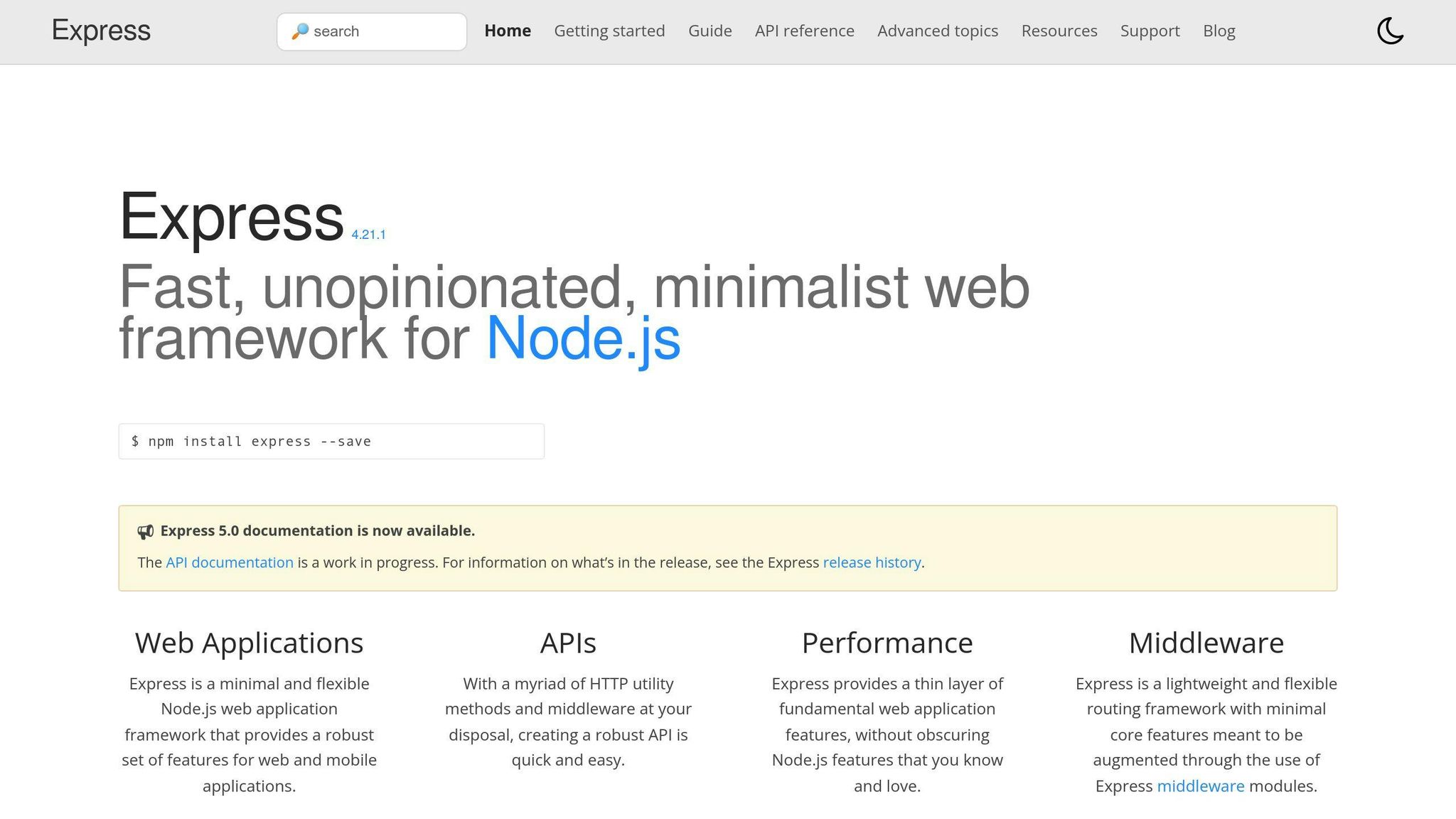
Performance and Speed
Express.js is a quick and efficient framework because it's built on Node.js, which is known for handling lots of things at once without getting bogged down. Here are some reasons it's fast:
- It's based on Node.js, which is great at doing a lot of tasks quickly.
- It's a simple framework, so it doesn't use much computer memory.
- It can deal with many requests at the same time efficiently.
- You can spread it out over several servers to handle more users.
Ease of Use and Learning Curve
Express.js is easy to pick up, especially if you're already familiar with JavaScript:
- Its simple setup makes it less intimidating for beginners.
- It has a straightforward way of handling website paths.
- You can add lots of features easily with additional packages.
- There's plenty of help available online for new users.
Community Support and Documentation
Express.js has a lot of fans and support:
- There's a detailed official website with guides and docs.
- You can find over 2,000 add-ons to do almost anything you need.
- Lots of people are talking about it and helping each other out on sites like StackOverflow.
- It's kept up-to-date by a community of developers.
Scalability
Express.js can grow with your project:
- You can run it on more than one server to handle more visitors.
- It has built-in ways to make things faster, like caching.
- Tools like PM2 can help manage your app as it gets bigger.
- It's easy to set up a system to manage where traffic goes.
Security Features
Express.js helps keep your app safe with:
- Tools for setting up security rules.
- A way to make sure web forms are being used correctly.
- Regular security updates.
- Support for adding your own security checks.
3. Spring Boot
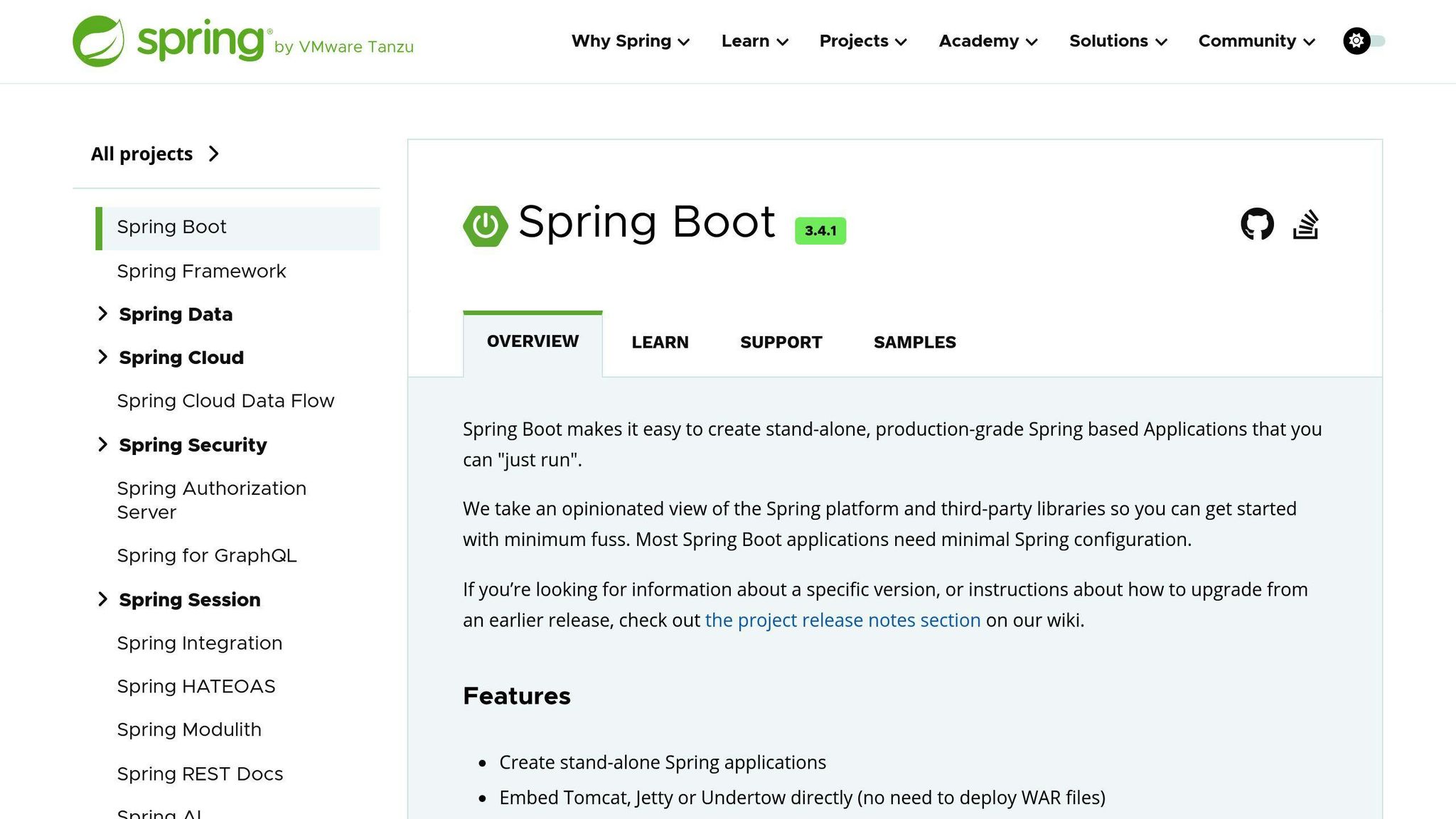
Performance and Speed
Spring Boot is known for being fast and efficient, and here's how it does it:
- Auto-setup: It figures out what you need and sets it up for you, so you don't have to.
- Runs on its own: You can run your app directly without needing a separate server, making things simpler.
- Ready for the real world: It comes with tools to check on how your app is doing and manage settings easily.
- Handles lots of users at once: It's good at dealing with many people using your app at the same time, without slowing down.
Ease of Use and Learning Curve
Spring Boot makes things easier by:
- Starting quickly: It has tools and shortcuts to help you get your app running fast.
- Keeping it simple: It prefers setting things up for you over making you configure everything.
- Learning as you go: You can start simple and learn more complex stuff as you need it.
- Lots of resources: There's a big collection of libraries and tools you can use.
Community Support and Documentation
Spring Boot has a lot of support:
- Good instructions: There are guides and how-tos that are easy to follow.
- Help when you need it: You can ask questions and get answers from other users.
- Many people use it: It's a popular choice for web development in Java, so there's a big community.
Scalability
Spring Boot can handle growing apps by:
- Adding more servers: You can spread out the work across several servers.
- Speeding things up: It lets you use caching to make your app faster.
- Dealing with lots of data: It's good at handling many requests without getting overwhelmed.
- Works well in the cloud: It's designed to fit right into cloud-based setups.
Security Features
Spring Boot keeps your app safe with:
- Easy sign-in: Supports common ways to log in and check who's who.
- Keeping things private: Helps you set up rules on who can see what.
- Protection from hackers: It has built-in ways to stop common attacks.
- Strong security: Uses Spring Security for even more safety features.
4. Laravel

Performance and Speed
Laravel is fast because it:
- Remembers pages to load them quickly
- Can do tasks in the background so your site doesn't slow down
- Makes talking to databases efficient
- Can handle more visitors by sharing the work
Ease of Use and Learning Curve
Laravel is user-friendly with:
- Clear and simple commands
- Easy-to-follow guides
- A big collection of add-ons from the community
- Quick tools for making apps
- Beginner-friendly learning path
Community Support and Documentation
Laravel has a supportive community:
- Well-written guides and tutorials
- Active online forums and help on Stack Overflow
- Updates and new features from the people who make it
- Lots of learning materials available
Scalability
Laravel can grow with your project by:
- Using caching to manage more visits
- A queue system for tasks that can wait
- Support for using many databases
- Easy to set up on more servers
Security Features
Laravel keeps your site safe with:
- Guarding against common internet threats
- Safe storage for user passwords
- Tools to stop SQL injection attacks
- A secure way for users to log in
- Encryption support
5. Ruby on Rails
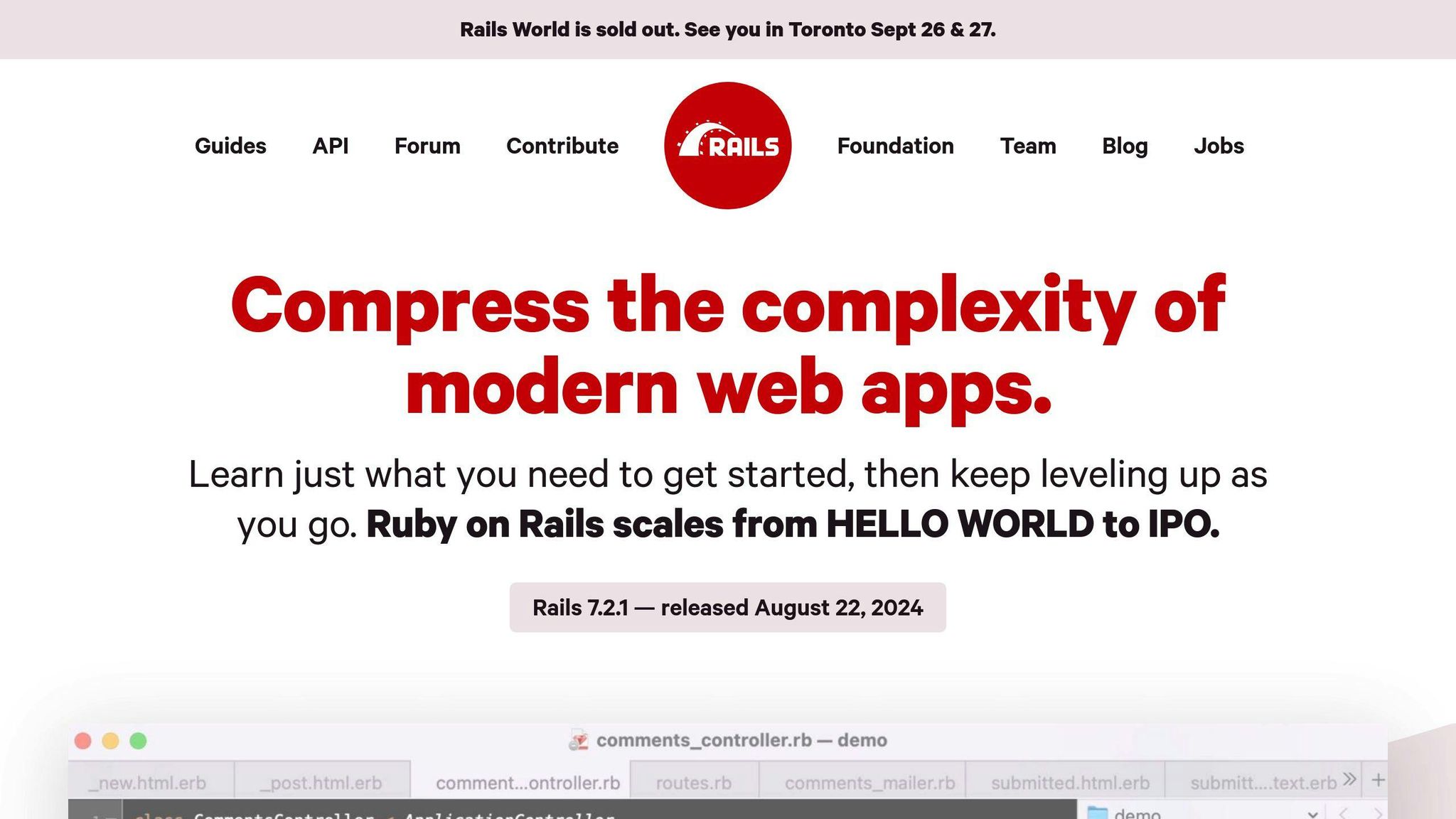
Performance and Speed
Ruby on Rails is pretty quick and efficient. Here's how:
- It remembers pages to make them load faster.
- It does the heavy lifting in the background, so your website runs smoothly.
- It talks to databases quickly, thanks to its smart design.
- It can manage more visitors by spreading work across different servers.
Ease of Use and Learning Curve
Ruby on Rails is user-friendly because:
- The Ruby language is easy to read and understand.
- It can automatically create basic parts of your app, like data models.
- You can easily add new features with "gems" (little pieces of code).
- It has a clear setup that helps organize your code well.
- There's a lot of help online, from tutorials to full courses.
Community Support and Documentation
Ruby on Rails has a strong community:
- Tons of questions and answers on Stack Overflow.
- Loads of resources like books and blogs.
- Regular meet-ups and talks for Ruby fans.
- It's open source, meaning lots of people contribute to making it better.
Scalability
Ruby on Rails can grow with your project:
- It makes pages load faster by remembering them.
- It can do big tasks in the background.
- It works well with cloud services, making it easier to handle more users.
- It uses tools to manage web traffic efficiently.
Security Features
Ruby on Rails is built to keep your site safe:
- It automatically protects against common web attacks.
- It has built-in ways to stop unauthorized access.
- It manages user sign-ins securely.
- It supports encrypted data, keeping sensitive information safe.
6. ASP.NET Core

Performance and Speed
ASP.NET Core is really good at handling lots of web traffic because:
- It can do many things at once without getting bogged down.
- It makes your code run faster right when you need it.
- It only uses parts it needs, so it doesn't get slow.
- It works well with tools that remember pages to make them load quicker.
Ease of Use and Learning Curve
ASP.NET Core makes building web apps easier with:
- A setup that keeps your code neat and easy to find.
- Helpful coding tips in Visual Studio.
- A smart way to organize parts of your app.
- Lots of guides and examples to help you learn.
You'll find it easier if you already know a bit about C# and .NET.
Community Support and Documentation
There's a lot of help available for ASP.NET Core:
- Detailed guides and help from Microsoft.
- A place to ask questions and get answers from other developers.
- It's an open project, so anyone can help make it better.
Scalability
ASP.NET Core can grow with your project because:
- It's really good at handling more web visitors.
- It works with tools that spread out web traffic.
- It uses smart ways to make your app run smoother.
- It's built for working with both big and small parts of your app.
Security Features
ASP.NET Core keeps your app safe with:
- A way to check who's using your app.
- Rules to control who can see what.
- Making sure all data sent is secure.
- Protection against common web attacks.
7. Flask
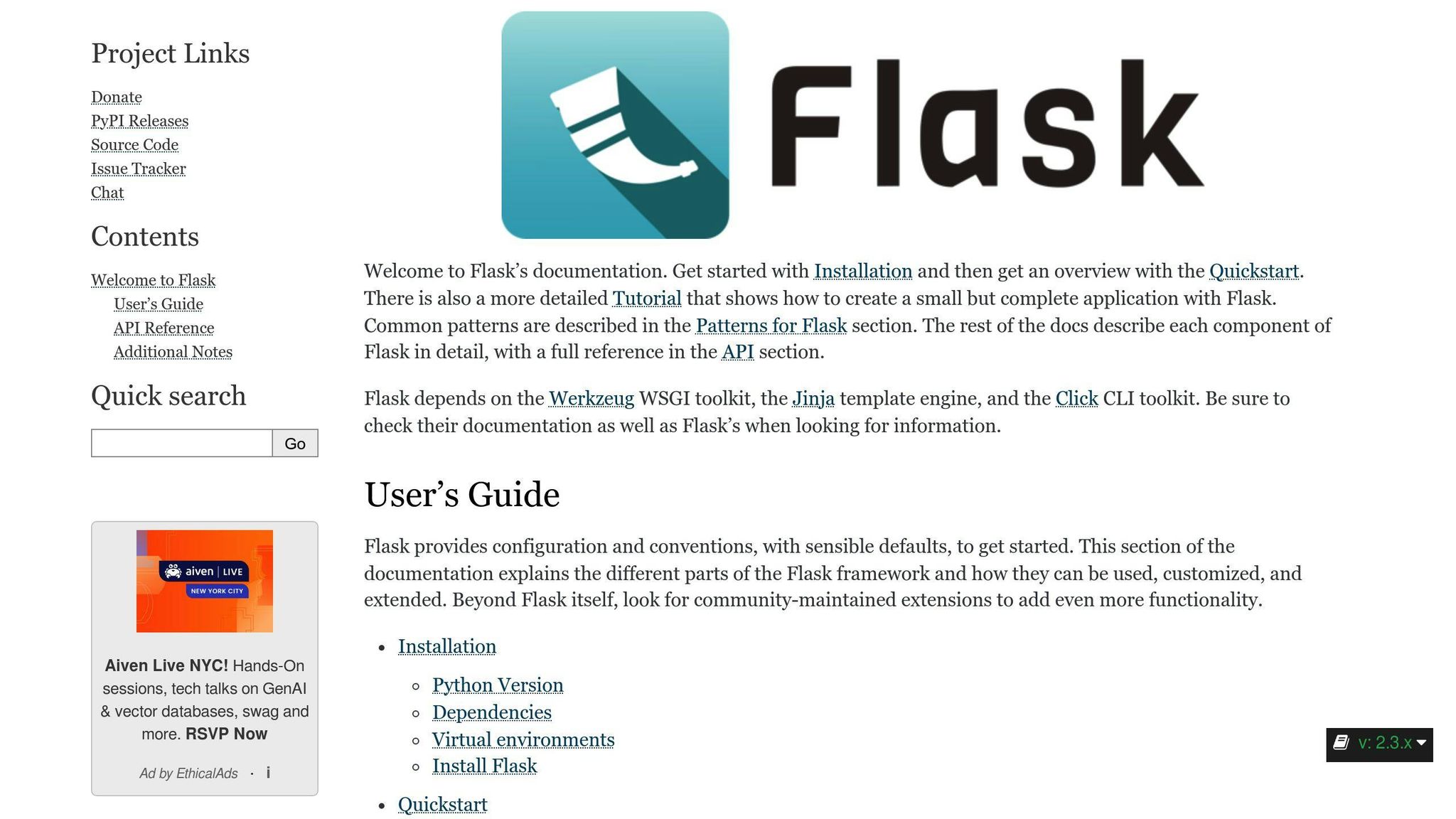
Performance and Speed
Flask is a lightweight framework, meaning it's pretty quick:
- It's simple, so it doesn't need a lot of computer power.
- It can handle many tasks at once without getting slow.
- You can use Flask on more than one server if you need to.
- It's good at doing tasks in the background without stopping other work.
Ease of Use and Learning Curve
Flask is easy for beginners:
- It's straightforward with not too much to learn at the start.
- The guides explain everything you need to know.
- There are lots of online tutorials.
- You can start with the basics and add more as you go.
Community Support and Documentation
Flask has a lot of help available:
- Places like Stack Overflow have answers to many questions.
- The guides cover everything about Flask.
- You can add new features with tools made by other people.
- Events and meet-ups are great for meeting other Flask users.
Scalability
Flask can grow with your project:
- It works with different databases.
- Using caching can help when more people visit your site.
- You can set up Flask apps with servers that manage internet traffic.
- It's ready for use with cloud services for bigger projects.
Security Features
Flask helps keep your site safe:
- It has protection against web attacks that trick your site.
- Flask-Security adds ways to manage who can access what.
- It stops harmful database commands by checking data first.
- Using HTTPS and SSL makes sure data sent is secure.
8. NestJS
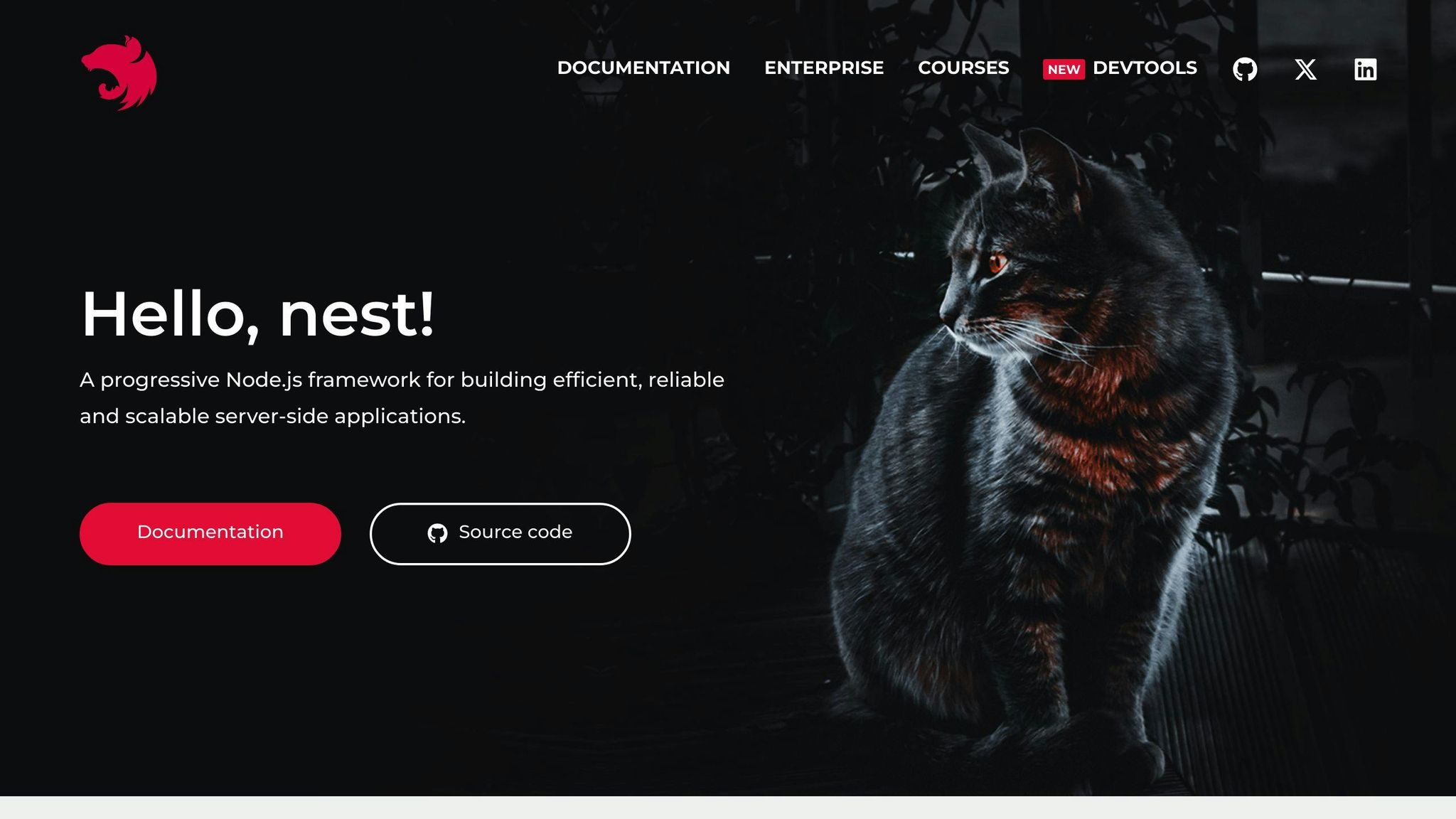
Performance and Speed
NestJS is known for being speedy because:
- It uses Node.js and JavaScript, which are quick.
- It organizes its parts well so everything runs smoothly.
- It can handle lots of users at the same time without slowing down.
- It's good at managing lots of web traffic with smart planning.
Ease of Use and Learning Curve
NestJS makes coding easier with:
- TypeScript, which helps catch mistakes.
- A neat way to keep your code organized.
- Features that save you from writing the same thing over and over.
- Plenty of guides and help for beginners.
Community Support and Documentation
The NestJS community offers:
- A detailed guide to help you get started.
- Places like Discord to talk and ask questions.
- Lots of free tools and code shared by others.
Scalability
NestJS can grow with your project because it:
- Fits well with cloud services for bigger projects.
- Lets you break your project into smaller parts for easier management.
- Can handle more work by spreading tasks out.
Security Features
NestJS keeps things safe with features like:
- Special checks to make sure data coming in is okay.
- Built-in tools to protect against hackers.
- Extra safety for forms and data changes.
- Ways to keep data secure and private.
9. Koa.js

Performance and Speed
Koa.js is quick and doesn't use a lot of computer power because:
- It's not bulky, so it doesn't slow down your computer.
- It can handle many tasks at once without getting stuck.
- You can add more features to make it run even faster.
- It can work on more than one server if your project gets really big.
Ease of Use and Learning Curve
Koa.js is user-friendly:
- It has clear guides to help you understand how it works.
- It uses easy coding methods for tasks that run in the background.
- You don't need to set up a lot of stuff - just add what you need.
- It starts simple but lets you add more features as you go.
Community Support and Documentation
The Koa.js community offers:
- Easy-to-follow guides and instructions.
- A place on GitHub to ask questions and talk to others.
- Lots of add-ons made by other users.
Scalability
Koa.js can handle growing projects by:
- Spreading tasks across several servers.
- Using caching to speed things up.
- Sending out responses efficiently.
- Using clusters to share the workload.
Security Features
Koa.js is secure because it has:
- Tools for checking inputs.
- Security measures to protect against online threats.
- Plugins for checking who's logging in.
- Encryption tools for keeping sensitive info safe.
10. Phoenix
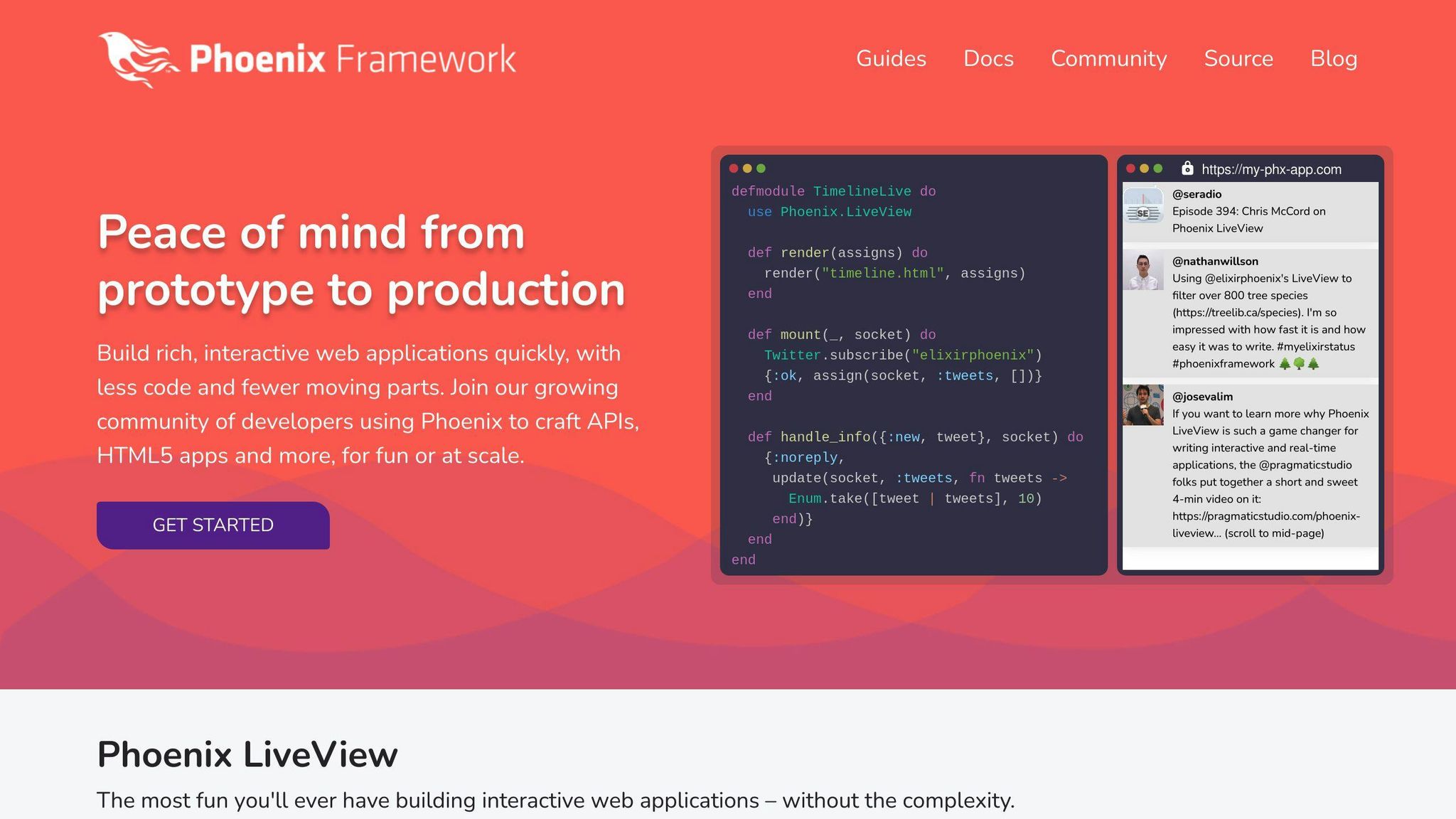
Performance and Speed
Phoenix is really quick and doesn't let you down because:
- It uses Elixir, which is good at doing a lot of things at the same time.
- It keeps a constant connection so everything feels instant.
- It can handle a lot of users all at once without any trouble.
- You can spread it out over more servers if you get more visitors.
Ease of Use and Learning Curve
Phoenix makes your job easier by:
- Using Elixir, which is pretty straightforward.
- Having an easy setup so you can start coding right away.
- Letting you build parts of your app separately but they all work together nicely.
- Offering clear instructions on how to get started.
Community Support and Documentation
The Phoenix community offers:
- Detailed guides for learning.
- Places to ask questions and chat with others.
- Events to meet more people who use Phoenix.
Scalability
Phoenix grows with your project because:
- It's great at handling more and more visitors smoothly.
- Adding more servers and resources is easy.
- Its setup makes it simple to keep everything running smoothly as you grow.
Security Features
Phoenix keeps things safe with:
- Tools to stop common internet attacks.
- Ways to handle who gets to see what in your app.
- Encryption for keeping private data safe.
- Support for secure web connections.
Conclusion
When it comes to building websites or web apps, choosing the right backend framework is super important. It's like picking the engine for your car. The framework handles the heavy lifting, like keeping your site secure, talking to databases, and making sure pages load properly.
Going for a framework that lots of developers use is a smart move. It means you'll find lots of help, updates, and extra tools made by other people. But what's popular isn't always what's best for you. You should also think about what languages you know, what your project needs, and what your team is good at. Even though lots of frameworks can do the job, using one that fits your existing skills can save you time and trouble.
Here's what to keep in mind when picking a backend framework:
- Performance - Choose a framework that's fast, can handle lots of visitors, and works efficiently.
- Ease of use - Look for something that's not too hard to learn, has good guides, and makes sense to you.
- Support - Go for a framework with lots of documentation and a community that's ready to help.
- Scalability - Make sure the framework can grow with you. It should be good at managing more users and data over time.
- Security - It should protect your site from common online threats.
While we've shown you some of the top frameworks for 2024, the best choice depends on your project's needs. Trying out a few and seeing which one fits your team and tech stack is often the best approach. If you're stuck, asking experienced developers for advice can also point you in the right direction.
Related Questions
Which backend technology should I learn in 2024?
If you're thinking about learning backend technology in 2024, here are some good options:
- Node.js - It's great for using JavaScript on the server side.
- Django - A Python framework that's really handy for building websites.
- Ruby on Rails - Uses Ruby and helps you make web apps quickly.
- Laravel - A PHP framework that's good for creating web apps and APIs.
- Spring - A Java framework that's powerful for building complex applications.
Learning about databases is also a smart move. SQL databases like MySQL and PostgreSQL, and NoSQL databases like MongoDB and Redis, are all valuable.
The best one for you depends on what you already know and what you're interested in. But all these options are popular and have lots of online support.
Which backend framework is best for future?
Looking ahead to 2024, these backend frameworks seem set for the future:
- Django - A Python framework that's great for big projects.
- Ruby on Rails - It's all about making web development faster and easier.
- Laravel - A PHP framework that's quick and great for APIs.
- ASP.NET Core - Microsoft's framework for building modern web apps with C#.
- Express - A straightforward Node.js framework for JavaScript developers.
The right one for you will match your tech stack and what you need for your project. They're all updated regularly and have big communities, which helps.
What is the most wanted backend framework?
The top backend frameworks for 2024 based on popularity are:
- Laravel - It's a PHP framework known for its speed.
- Django - A Python framework that's great for scaling up.
- Spring Boot - It's for Java and Spring developers who want to build applications quickly.
- Ruby on Rails - Known for helping developers work faster.
- ASP.NET Core - Microsoft's framework for modern web apps.
These frameworks are liked because they have lots of resources, updates, and a supportive community.
Is Laravel the best backend framework?
Many people think Laravel is the best for PHP backend work. Here's why:
- It's fast and has a great system for handling web requests.
- It makes working with databases easier.
- It helps you stay organized with a modular system.
- It comes with built-in tools for user login and permissions.
- It encourages clean code by following the MVC pattern.
- There's a huge selection of packages to use with it.
Big names like Alibaba and Asana use Laravel. It has a huge community that offers lots of help and resources. Plus, its syntax is clear and enjoyable for developers.

.png)








